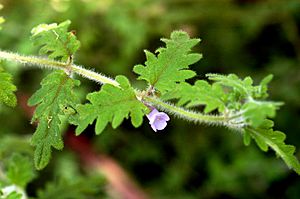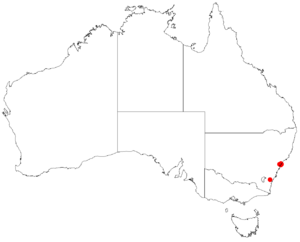Tranquility mintbush facts for kids
Quick facts for kids Tranquility mintbush |
|
|---|---|
 |
|
| In Bouddi National Park | |
| Conservation status | |
| Scientific classification | |
| Genus: |
Prostanthera
|
| Species: |
askania
|
 |
|
| Occurrence data from AVH | |
The Tranquility mintbush (Prostanthera askania) is a special type of shrub. It only grows in Australia, meaning it is endemic there. This plant has light purple flowers and leaves that smell very strong, like mint! Its leaves are shaped like eggs and have small teeth on the edges.
What it Looks Like
The Tranquility mintbush is a small, bushy plant. It can grow up to 2.5 meters (about 8 feet) tall and just as wide. Its leaves are a dull green color and have a strong minty smell. They are shaped like eggs, wider at the bottom and rounded at the top. The leaves are covered with soft hairs and can be up to 40 mm (about 1.5 inches) long. Their edges have small teeth pointing forward.
The plant's flowers are usually light purple or bluish. They grow in groups of 4 to 10 at the ends of the branches. Each flower petal is about 12-14 mm long. You can see these pretty flowers from June to December.
How it Got its Name
The Tranquility mintbush was officially described in 1997 by a scientist named Barry John Conn. He wrote about it in a science journal called Telopea.
The second part of its scientific name, askania, comes from Askania Park. This is a private nature area west of Ourimbah, where the plant grows in sheltered valleys.
Where it Grows
The Tranquility mintbush only grows in a small area in New South Wales, Australia. You can find it near creeks that flow into Brisbane Water or Tuggerah Lake, close to Gosford.
It likes to grow as a smaller plant under taller trees, often near rainforests. It prefers flat areas or gentle slopes. The soil it grows in is usually made of sandstone or river deposits.
Why it Needs Protection
Sadly, the Tranquility mintbush is an "endangered" plant. This means there are not many of them left in the wild. Both the Australian Government and the New South Wales Government have laws to protect it. These laws, like the Environment Protection and Biodiversity Conservation Act 1999, help make sure this special plant can survive and thrive.
See also
 In Spanish: Prostanthera askania para niños
In Spanish: Prostanthera askania para niños


